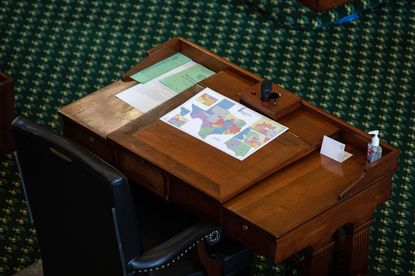Texas gained 2 new House seats thanks to explosive Latino growth. Both new districts are majority white.


Texas gained two congressional seats after the 2020 U.S. census, thanks to a decade of explosive growth. But while 95 percent of that growth is attributable to new Black, Latino, and Asian residents, The Texas Tribune reports, the Texas Legislature gave final approval Monday night to a new congressional map that gives "white voters effective control of both" new districts. Gov. Greg Abbott (R) is expected to sign off on the new maps.
In fact, voters of color lost representation under the new map, drawn by the Republicans who control the entire Texas redistricting process. The new map includes seven majority Latino districts, down from eight, and zero majority Black districts, down from one. The state gained almost 11 new Hispanic residents for every white resident over the past decade, the Tribune notes, and half the 4 million new Texans in the 2020 census are Latino. There are now roughly equal numbers of white and Latino residents of Texas.
"This year's political mapmaking marks the first time in nearly half a century that Texas lawmakers are free to redraw the state's maps without federal oversight meant to protect voters of color from discrimination," the Tribune reports. "The Republicans who led the redistricting process offered little defense of the maps from the Senate and House floors before the final votes," but they have previously said they are complying with federal law and pursuing a partisan, not racial, gerrymander. Civil rights groups are already suing the state, claiming violations of the Voting Rights Act.
Subscribe to The Week
Escape your echo chamber. Get the facts behind the news, plus analysis from multiple perspectives.

Sign up for The Week's Free Newsletters
From our morning news briefing to a weekly Good News Newsletter, get the best of The Week delivered directly to your inbox.
From our morning news briefing to a weekly Good News Newsletter, get the best of The Week delivered directly to your inbox.
On the partisan front, the Republican maps "protect their slipping grip on Texas by pulling more GOP-leaning voters into suburban districts where Democrats have made inroads in recent years," The Associated Press reports. The map appears to focus on fortifying GOP incumbents rather than maximizing GOP numbers through carving narrowly Republican districts. Still, Republicans will win one or both of the new districts, giving them 24 or 25 seats out of 38, up from their current 23 out of 36 districts.
"What we're doing in passing this congressional map is a disservice to the people of Texas," and "it's shameful," state Rep. Rafael Anchía (D) told his colleagues before the vote. "I'd love to be able to say it is a stain on the legacy of voting rights, but that seems to be the playbook decade after decade after decade in this state."
Create an account with the same email registered to your subscription to unlock access.
Sign up for Today's Best Articles in your inbox
A free daily email with the biggest news stories of the day – and the best features from TheWeek.com
Peter has worked as a news and culture writer and editor at The Week since the site's launch in 2008. He covers politics, world affairs, religion and cultural currents. His journalism career began as a copy editor at a financial newswire and has included editorial positions at The New York Times Magazine, Facts on File, and Oregon State University.
-
 The hunt for Planet Nine
The hunt for Planet NineUnder The Radar Researchers seeking the elusive Earth-like planet beyond Neptune are narrowing down their search
By Chas Newkey-Burden, The Week UK Published
-
 Magazine interactive crossword - April 26, 2024
Magazine interactive crossword - April 26, 2024Puzzles and Quizzes Issue - April 26, 2024
By The Week US Published
-
 Magazine solutions - April 26, 2024
Magazine solutions - April 26, 2024Puzzles and Quizzes Issue - April 26, 2024
By The Week US Published
-
 Mark Menzies: Tories investigate MP after 'bad people' cash claims
Mark Menzies: Tories investigate MP after 'bad people' cash claimsSpeed Read Fylde MP will sit as an independent while party looks into allegations he misused campaign funds on medical expenses and blackmail pay-out
By Arion McNicoll, The Week UK Published
-
 Why Johnson won't just pass Ukraine aid
Why Johnson won't just pass Ukraine aidSpeed Read The House Speaker could have sent $60 billion in military aid to Ukraine — but it would have split his caucus
By Peter Weber, The Week US Published
-
 Sudan on brink of collapse after a year of war
Sudan on brink of collapse after a year of warSpeed Read 18 million people face famine as the country continues its bloody downward spiral
By Peter Weber, The Week US Published
-
 Trump's first criminal trial starts with jury picks
Trump's first criminal trial starts with jury picksSpeed Read The former president faces charges related to hush money payments made to adult film star Stormy Daniels
By Peter Weber, The Week US Published
-
 How will Israel respond to Iran's direct attack?
How will Israel respond to Iran's direct attack?Speed Read Iran’s weekend attack on Israel could escalate into a wider Middle East war
By Peter Weber, The Week US Published
-
 US, Israel brace for Iran retaliatory strikes
US, Israel brace for Iran retaliatory strikesSpeed Read An Iranian attack on Israel is believed to be imminent
By Peter Weber, The Week US Published
-
 Congress honors real-life Rosie the Riveters
Congress honors real-life Rosie the RivetersSpeed Read These American women reshaped the work force during World War II
By Peter Weber, The Week US Published
-
 Outgunned Ukraine could fall, US general warns
Outgunned Ukraine could fall, US general warnsSpeed Read Without more US aid, Ukraine is at risk of losing the war
By Peter Weber, The Week US Published